Adventurous Kate contains affiliate links. If you make a purchase through these links, I will earn a commission at no extra cost to you. Thanks!
The most prominent building in Mosta, Malta, is the beautiful Mosta Rotunda. Also known as the Mosta Dome, it is The Sanctuary Basilica of the Assumption of Our Lady, a Roman Catholic parish church and Minor Basilica.
This church in Mosta features one of the world’s largest unsupported domes and displays a replica of a World War II bomb that crashed through the dome but miraculously did not detonate upon impact.
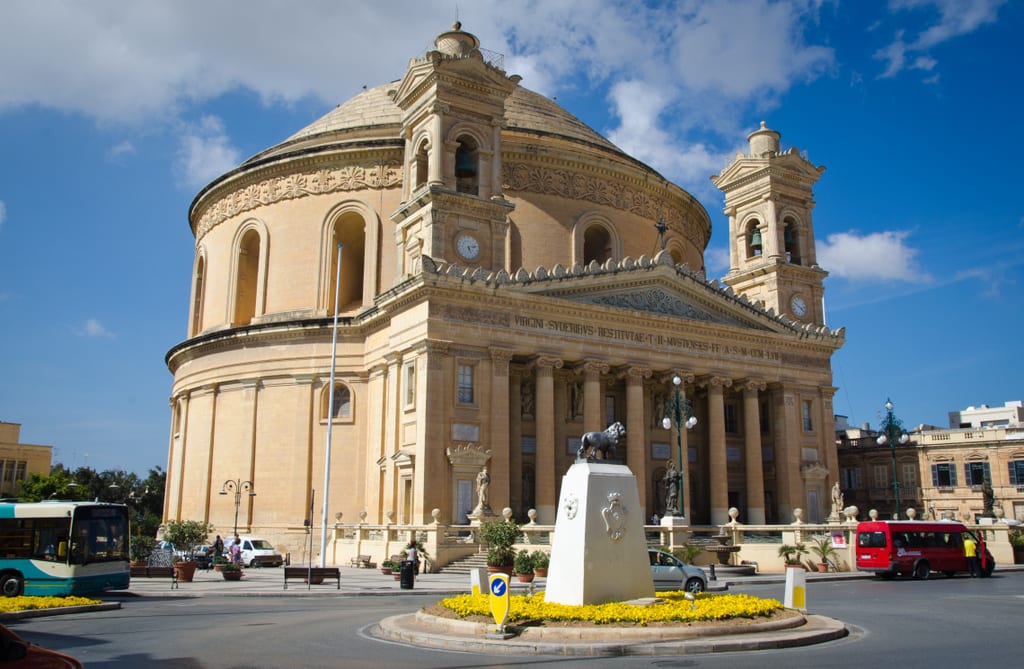
Malta Churches
If anywhere on the planet is more Catholic than the Vatican, it’s Malta.
From giant paintings of the Virgin Mary hanging in Maltese bedrooms to religious festas with saints carried through the streets to incredibly ornate churches courtesy of generous parishioner donations, Malta is a place where life revolves around the Catholic faith.
Malta is home to more than 360 churches in total — an incredible feat when you consider that the island is just 122 square miles.
The Church of St. Paul’s Shipwreck in Valletta is the oldest church in Malta and purportedly holds the wrist bone of St. Paul. St. Mary Magdalene’s Chapel is a tiny, one-room church overlooking the Dingli Cliffs. The church of Xewkija in Gozo has the second-largest church dome in Europe after St. Peter’s Basilica in Rome.
And then there is the Mosta Rotunda — the church that held a miracle.
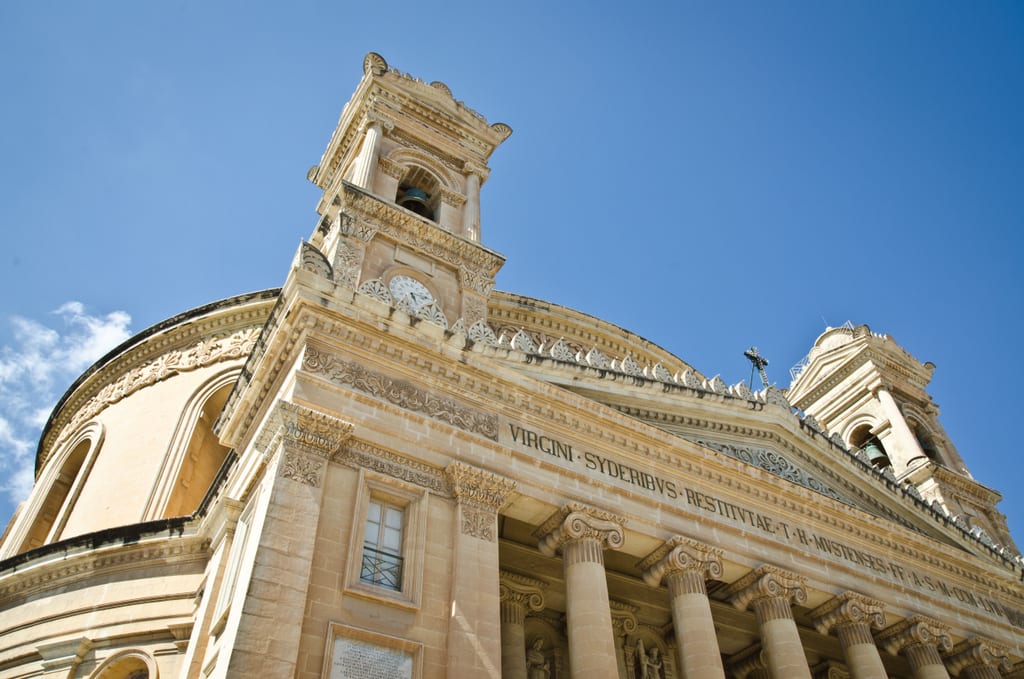
The Mosta Dome Bomb
During World War II, Malta was a strategic outpost for the Allies. Consequently, it was heavily bombed.
The bombing was so extensive that by the end of the war, Malta had become the most-bombed nation on the planet.
(Laos holds this title today, following its bombing during the Vietnam War.)
On April 9, 1942, two German bombs fell on The Church of the Assumption of Our Lady in Mosta, a city in central Malta. Mass was going on at the time, and more than 250 parishioners were in the church.
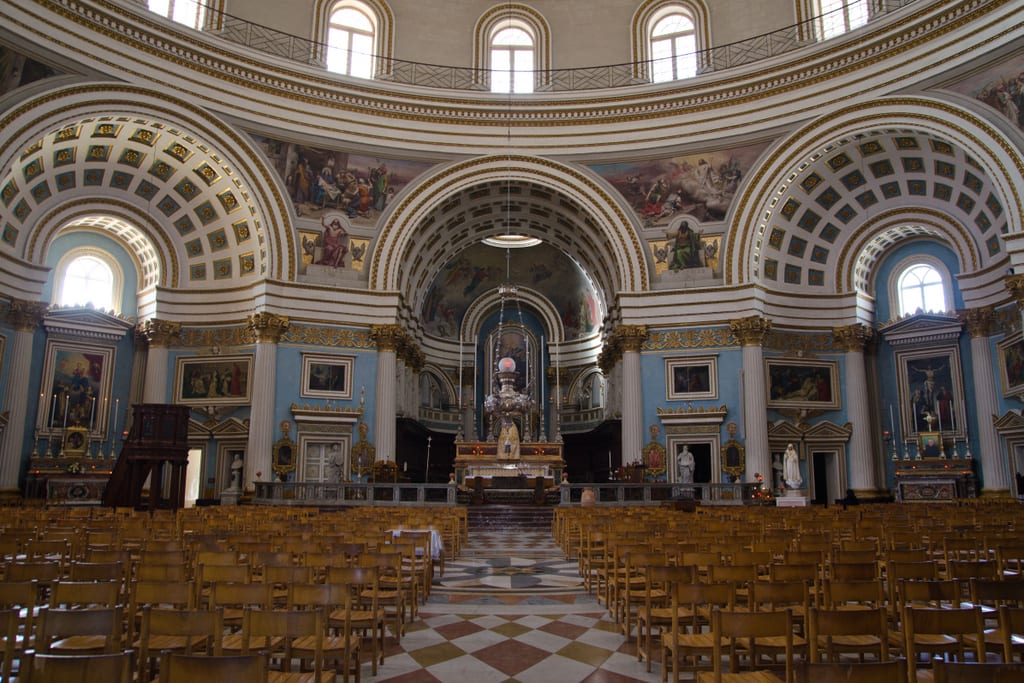
Alarms rang out ahead of time, and while some people left the church, others stayed inside and prayed.
The first bomb pierced the Mosta rotunda, ricocheted, and fell onto the floor of the church. The second cleared the left side of the triangle on top of the church’s facade.
Those bombs had every reason to explode — but neither of them did.
It was hailed as a miracle. Somehow divine intervention prevented the church — and the town — from turning to rubble.
The bombs were promptly defused by the military and later dropped into the sea.
Today, the Mosta Dome is celebrated for its miracle. You’ll find a replica of the bomb that fell through the dome on display in the back of the church.
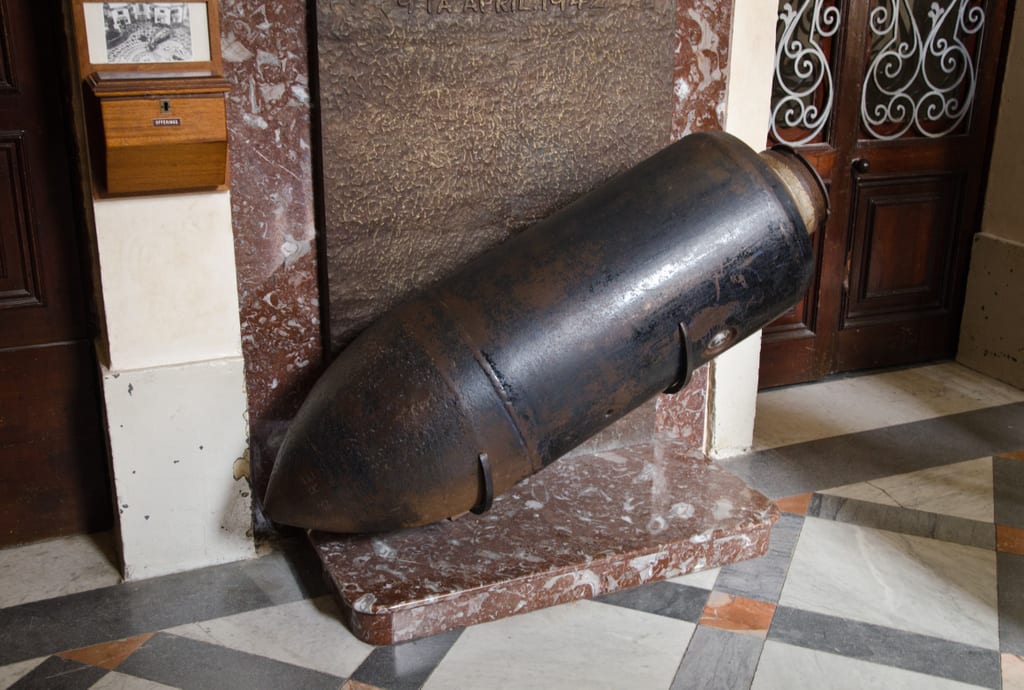
But was it really a miracle that the bomb didn’t explode? There is another story – though I have no idea if there’s any truth to it.
Czechoslovakian workers (under Nazi rule) were recruited as labourers to sustain the German military campaign, and it has been said that some of these workers created the bomb that fell on Mosta Dome. But, as the story goes, the workers were anti-Nazi and instead of filling the bomb with explosives, they filled the metal shell with sand!
Whether or not this was a true miracle, I don’t understand the point of bombing a church — or any house of worship. Seriously, what is the benefit of this?
As horrible as war is to begin with, why would an enemy choose to drop bombs directly on a house of worship filled with innocent people? Why get people in the one place where they feel safe?
It could have been that the bombs were released at the wrong time on the way to a port. Or maybe it wasn’t. Maybe they intended to demoralize the population in the one place that meant the most to them. Believe me, in Malta the churches are sacred.
It’s a question that still resonates today in the age of drone strikes and home-grown terrorism.

How Old is the Mosta Church?
The earliest church on this site was built around 1614. The current Mosta Dome was designed by the architect George Grognet de Vassé who drew his inspiration from the Pantheon in Rome.
The first stone was laid in 1833 and the church was completed in 1860. The new rotunda was so big that the old church was still standing inside and was then dismantled!
The Rotunda has a diameter of 56 meters on the outside and 39 meters on the inside. It’s HUGE. The main façade has six Ionic-style columns and the walls supporting the dome are about 9m thick.
Depending on the source, it has been said that Mosta Rotunda is the 3rd or 4th largest dome in the world.
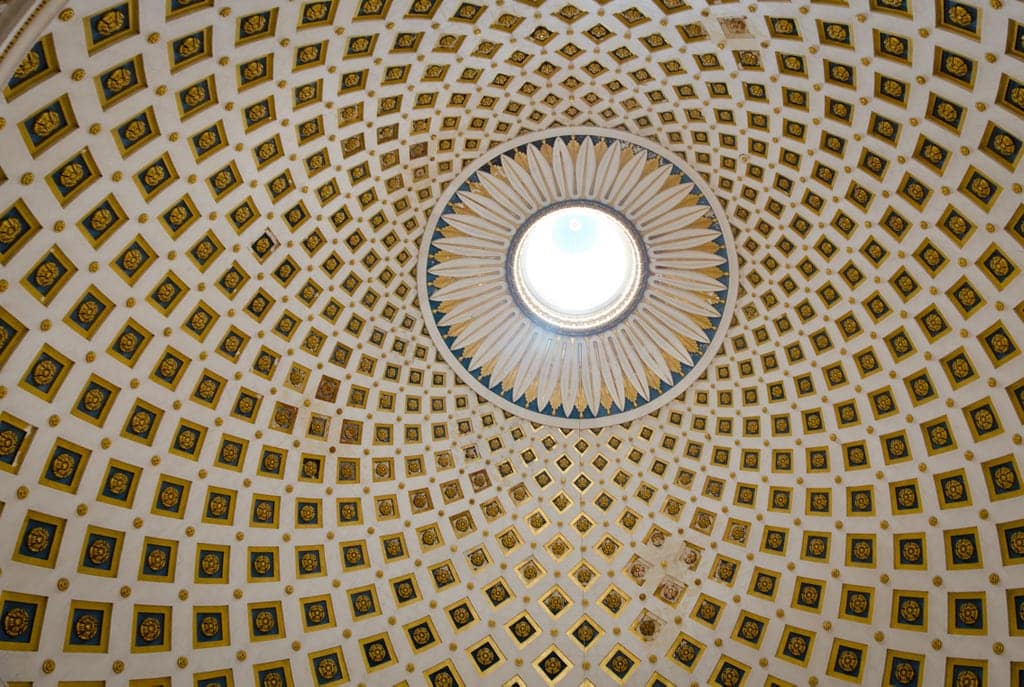
Visiting Mosta Rotunda
Of Malta’s 360+ churches, you won’t find one with a better story than the Mosta Rotunda.
While you are visiting, you can take a flight of stairs up to the roof for a beautiful view. You can also visit the fascinating WWII shelters and learn more about Malta’s crucial role during the war.
The Mosta Rotunda is open to visitors Monday to Friday from 9:30 to 17:30 (5:30pm), Saturday from 9:30 to 16:30 (4:30pm), and Sunday from 12:00 to 16:30 (4:30pm).
Admission fees to the Mosta Rotunda are as follows:
- €2 to visit Mosta Basilica
- €2 to visit World War II Shelter
- €3 to go up on the portico and enter in the inner gallery of the church
- €3 for combo ticket to visit Mosta Basilica and World War II Shelter
- €5 for combo ticket to visit Mosta Basilica, World War II Shelter and go up to the inner gallery of the church
Mosta Malta is easily accessed by bus from Valletta and other cities throughout the island.
If you’ve got a car, Mosta is a good destination to pair with a trip to Mdina and the Dingli Cliffs. Parking can be a challenge and while there are lots near the church, you might be better off taking a space on the street.

More Things to do in Mosta, Malta
Mosta may be a small town on a small island, but there are quite a few interesting places on offer! Here are some fun options:
Guided evening tour of Valletta, Mdina, and Mosta — See the monuments, churches and buildings all lit up at night.
Half-Day Tour of Mosta, Ta’Qali Crafts Village & Mdina — A great cultural offering in Malta.
If you’re a WWII buff, don’t miss the Lascaris War Rooms museum in nearby Valetta.
Take a horseback riding tour through the Maltese countryside.
Visit the Mosta Bridge (or try abseiling or ziplining!).
Take a walk through the Mosta Bride Garden.
This post was brought to you as a result of the Blog Island Malta campaign, created and managed by iambassador in partnership with the Malta Tourism Authority and the support of Air Malta. Adventurous Kate maintains full editorial control of the content published on this site.
The interior photo’s of the church are amazing.
As far as bombing the church, I think the tactic of bombing sacred places for the sake of demoralizing the population is pretty common and extraordinarily disgusting (as if war wasn’t in the first place).
Lovely photos! Bombing during WW II was an extremely inaccurate science. The chances of the Germans actually choosing to bomb a church and then accurately hitting such a small target twice would have been almost nil at the time.
I love Malta my dad was in the Army there back in the early 50s left when I was 9yrs been back 5 times hope to go again soon
How strange (but amazing!) that the bombs just didn’t blow up! Crazy as well that it was the most bombed country in the world, especially considering it’s not a country that would instantly spring to mind if you thought of World War II.
Well, to be fair, Malta wasn’t a country during World War II. It was British. And it was one of the main British naval bases in the Mediterranean.
To be accurate malta has been a country for centuries even before the Roman era.
Admittedly controlled by various nations be they Roman, phoenican, France or the ottomans.
Brittan kicked out Napoleon making Malta was a separate country as a territory in the British commonwealth up until independence in the 70’s.
Such a cool little church. 🙂
Kate,
I have to respond to your question of, “Why bomb a church?” Seventy years ago ALL aerial bombs were guided only by gravity. Accuracy was measured in kilometers. So, depending on the aircraft type, hundreds were dropped on each mission. The phrase used was, “carpet bombing”. That accuracy pertained to those that were on target. Strays routinely landed miles from their intended destination. The fact that only two hit the church is evidence that it probably was not a target. An examination of real targets and likely approaches would confirm this.
Frank
That makes so much sense, Frank! Mosta is right in the center of the (small) island, so it was probably the best they could have done.
Kate,
About 1.5 kilometres to the South -West of the dome is, or rather was during the war Ta’ Qali airfield, from where the RAF launched aircraft, this may have been the target for the bombs.
I believe the runway area now sustains all sorts of small industries.
Lived opposite the defunct airport during the 70’s – fabulous time with fabulous people.
Alan
What a beautiful church and an even more beautiful story. It’s hard not to believe in miracles when you hear accounts such as these.
The bombs dropped on Malta during WW2 were a combined effort of the Germans and Italians, most of the Italians didnt really want to be in the war and certainly did not want to bomb their Maltese neighbours, there are many stories of Italian planes dumping their bombs in the sea and flying back home. The reason Malta was such a target was because of its strategic position in the middle of the Mediterranean, The allied forces could fly missions from Malta across enemy territory – as others have said here the churches were not the target but the island as a whole – You should have gone to Valletta and watched The Malta Experience (search it on youtube), You would then understand the sacrifice the Maltese people gave to the allied forces and in particular the UK – that’s why the island was awarded The George Cross – for bravery and loyalty – It makes me proud to have Maltese blood in me !!
I went to the military museum in Valletta, and it’s a must if you’re interested in learning about Malta’s role in the war.
My Mum and all of her 15 siblings and her parents were in the church when it was bombed!! Very much a miracle otherwise I wouldn’t be here today to share this info with you.I couldn’t be more proud of my Mum and proud to be half Maltese what a beautifu and brave country Malta is. They truly did deserve the GC, the Malta Experience is a must!! The Masltese people were so brave!! God bless Malta !!!
It was my grandad who was based there during the war in the Army that assisted with defused said bomb, his son Ray Reece my dad had his early teenage years there being bombed to bits….lots of stories!
Carmen, that’s amazing to hear about your mother and so many of her siblings that were very lucky to escape this unexploded bomb – can’t imagine how scared they must have felt as they stood staring at it as it rolled across the floor..
Louise, i would be very interested it hearing any stories or information about your granddad, as mine also was part of the team that defused this bomb. You must be familiar with the photograph of the team on display in the back of the church… my granddad is the 3rd one standing from the left.
Myself and my family were present at the reviling of the plaque to commemorate the Royal Engineers bomb disposal section by Malta’s Prime Minister last week. It also recognises the continued work done by the Royal Engineers to 1970 and thereafter by the Armed Forces of Malta.
Beautiful photos, and the backstory is definitely resonating. I can’t believe the bombs didn’t blow up… lucky for the people that were inside.
I just discovered your blog. Beautiful photos! I guess I should pack my bag right away and get there 🙂
Proud to be Maltese and from Mosta … Malta is such a history and cultural jewel for those interested 🙂 A hello from sunny Malta 🙂
Sorry ‘historical’ not ‘history’ … my bad 🙂
That’s incredible! I’m finding more and more reasons to visit Malta…
what an amazing story! and gorgeous church. thanks for sharing!
That’s pretty crazy. I love stories like this!
I think any time a deadly weapon fails to hurt people, it is a miracle!! 🙂
And I could totally hear the anger and frustration in your voice, Kate, when I read, “Why bomb a church?” I so agree. As other people have said here, I don’t think it was on purpose, but nowadays, with our improved technology, places like this could – and do – become targets. It’s so wrong.
“The bombing was so extensive that by the end of the war, Malta had become the most-bombed nation on the planet.” Wow, I never knew. These photos are lovely. Thank you for sharing!
Happy travels 🙂
Except that Malta wasn’t a nation at the time.
What an amazing story! I never realised that there were so many churches in Malta. It is definitely a country I would love to visit.
Here is a film, worth watching if your interested in Malta and WW2
https://www.youtube.com/watch?v=M30KC-mep7k#t=11
I will be doing a cruise this September that stops in Malta, maybe a could visit this church, it will be in my priorities. Thanks for the info! 🙂
Between me and you, if you’ve got one day in Malta, I’d prioritize Valletta and the magnificent St. John’s Co-Cathedral. 😉
I absolutely love visiting all different kinds of religious buildings around the world. Seeing these pics has given me yet another reason I have to visit Malta. While it looks nice on the outside, the inside looks amazing. Thanks for sharing Kate!
If you loved the inside of this church you should definitely pay a visit to the St John’s Co-Cathedral in Valletta Malta as well 😉
http://www.jwrigley.com/wp-content/uploads/2011/01/St-Johns-CoCathedral_01.jpg
Thanks for the info on Malta; I’m greatly inspired to see it for myself someday!!
I would imagine that whoever controlled Malta during the war held a strategically located bit of land and I’m not surprised to know that it was so heavily bombed. I’m motivated now to learn more of its history. The story of the church of Our Lady in Mosta is fascinating. What great fortune for the church community.
Thank you for sharing the history of the church, I always appreciate those stories and details. Your pictures are beautiful and I hope to see the Miracle Church of Mosta someday soon.
My dad was an ack ack gunner on malta during ww2 and i remember an old photo of the hole in the rotunda, along with other military who were there at the time he helped to evacuate the church . I am going out in the middle of april 20151
Kate,
About 1.5 kilometres to the South -West of the dome is, or rather was during the war Ta’ Qali airfield, from where the RAF launched aircraft, this may have been the target for the bombs.
I believe the runway area now sustains all sorts of small industries.
Lived opposite the defunct airport during the 70′s – fabulous time with fabulous people.
Alan
I am half Maltese! my Mum was in the Church at the time of the bombing she was only 14 years old some of the amazing stories she has shared with us you wouldn’t believe!! My Mum is an amazing Lady she lived a couple of hundred yards from Mosta Dome what an amazing Church. I am so proud to b part of a magnificant country
Hi Carmen,
I am fascinated by the story of this bombing, and wondering if there is any singular authoritative source on the event such as a book or documentary. Do you know of anything like this?
I have also heard that some of the German pilots returned to Malta after the war to examine the church. Do you know if there is any validity do this?
Thank you! Your friend, John
Hi John, very little has been written about the Royal Engineers Bomb Disposal Unit, but S.A.M Hudson has written a book titled UXB Malta. The book covers this story and reveals what it is like to work in Army bomb disposal in the most bombed place on Earth. Her father was one of the Officers in charge of incredibly only 2 bomb disposal teams on Malta during WW2.
I was fortunate to meet Susan Hudson during the revealing of the plaque to commemorate Royal Engineers Bomb Disposal Unit at Upper Barrakka Gardens last week.
Miracle??
It all depends on how one looks at things. Please try to use your “God-given” imagination.
During the WWII German Luftwaffe air-raids on Malta, they managed to drop a 500 lb bomb on a Maltese brothel (probably not by design).
The place was full of prostitutes and their clients and that bomb failed to explode.
Not one person inside the building was injured.
Nothing was mentioned in the press about this incident.
I was born in Mosta late in March of 1942 in an 8 hours air raid and according to my older sister I was baptized on the 9th April 1942 in the Mosta Dome at 4.00 pm, due to the fact that when my father took me to be baptize earlier, the priest wouldn’t baptize me then because my father was a Strickland voter and that was a no no in the eyes of the church in those days later he sent for my father to have me baptized on 9th April at 4.00 pm. At around 5.00 pm the bomb entered the Dome. Having said that, I do believe that in the late 1980’s or early 1990’s an old German tourist entered the church and he couldn’t stop crying, when approached by a priest as to why he was crying the tourist informed the priest that he never expected the church to still be in standing, as he was the Pilot that dropped the bombs on the church and as he said it was common practice that any bombs left in the bay after a raid it was common practice just to drop them anywhere, and when he released those bombs he never realized until too late that they were going on such a magnificent church. Up until the time that he visited that church he had lived with the guilt of having destroyed that church.
I am from Mosta my self but I live in uk thanks for sharing such good story’s here last time I went in the church was when unfortunately I lost my beautiful mum also my teacher was Dun carm sure those from Mosta knows Dun carm
I have visited Malta four times, and my husband has visited three times. Malta is such a draw for us, mainly because of the seriousness of the faith of Maltese people, and the atmosphere it produces in the country as a whole. Of course, there are many other winsome attributes of Malta which bring us back again and again. It’s a strangely wonderful place. Mosta Dome is the place we always visit, and it’s great to see such a thriving congregation with lots of children and teenagers involved in the life of the church. In our opinion, God wanted that church to continue to turn people’s minds and hearts to what’s essential.
One of my high school teachers once told my class this story. She said it was very close to heart for her and we asked her why. She said that her grandparents or great-grandparents were in this church at the time when the bomb went in. The priest just said that they would live together or they would die together. When the bomb didn’t go off after five minutes, no one dared to move. It never ended up blowing up. If this bomb were to have blown up, my teacher wouldn’t have been here today.
Wow. I can’t imagine how frightening that must have been. What a miracle.
The Maltese are a God-loving people.
I have visited this truly beautiful church three times. Malta and Gozo are one of my favorite places to visit. Fr. Mario Tong the resident pastor gave me a personal tour each time. I also talked to the woman who was dusting the statues and she told me she loves coming to work in such a Holy and beautiful place. She was beaming with pride. The people are so friendly. I can’t say enough about their living the Christian message of love and hospitality.
Great pictures and story Kate.
I was in Malta in December and visited the Rotunda as well. On your first picture of the dome, there’s a slightly faded section at around 5 o’clock at the bottom. A local explained to me that this is the bomb damaged area which was repaired, but subsequently there was water damage..
Outside, close to the steps is the WW2 Air Raid Shelter and I managed to get down it when it was open on 28th Dec 17…..I did a 9-minute video on YouTube……
https://www.youtube.com/watch?v=u4Z1OHs6KS8&t=54s
Cheers, Mike
According to a guidebook, Mosta was along the air approach to a nearby RAF airfield and was bombed on several occasions due to its proximity to the airfield, a legitimate target.
My Nunna was born on 1938 and was 4 year old when she got shot in the hand and still has the scar. She doesn’t remember much but remembers the country in lock down.
My Nunna is 80 years old now and talks about her experience in Malta ??
My Nunna remembers running to a little girl on the road st night time she got to the little girl but was shot in her arms that’s how my Nunna was shot in her hand
Unbelievable, having two bombs land on the church and not go off. It was a miracle, the Holy Mary protected it. She is such amazing person, so pure and good, I would love to meet her.
I heard a story from a historian sometime ago that the German pilot had to drop the bombs because of a technical error in the plane but he new that they won’t explode because the pilot failed to arm the bomb’s fuse prior to its release. He would later document this after the war ended.